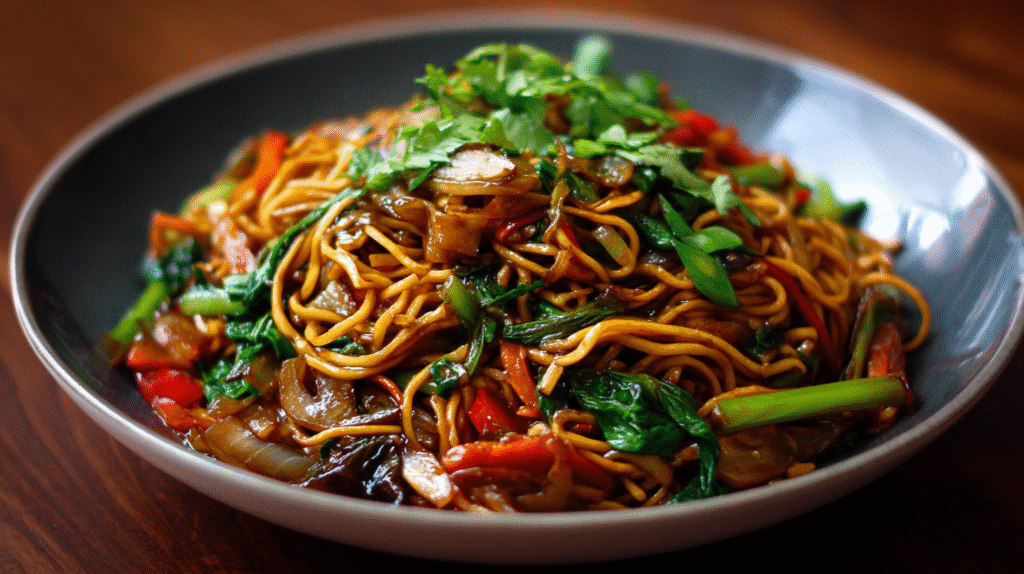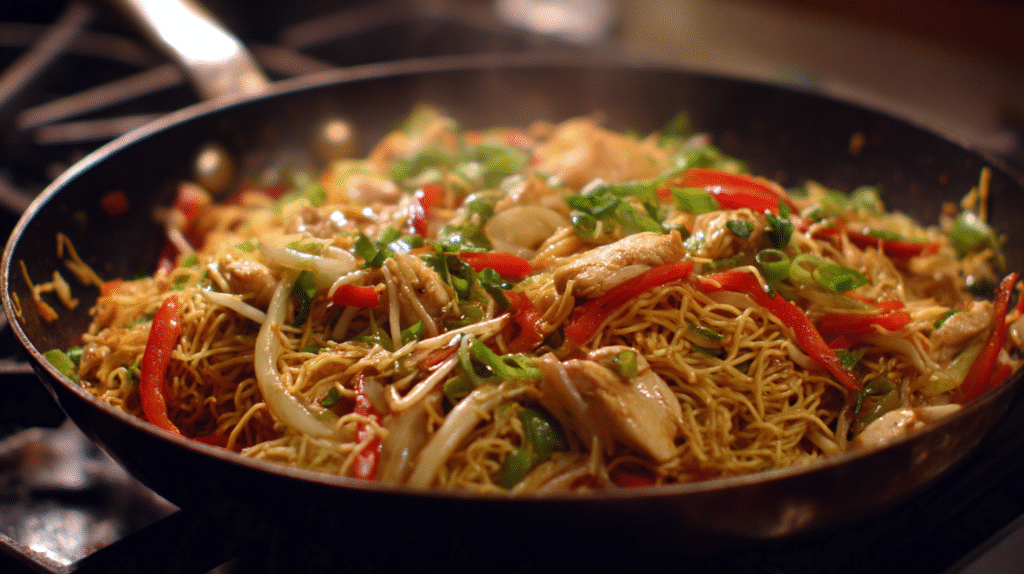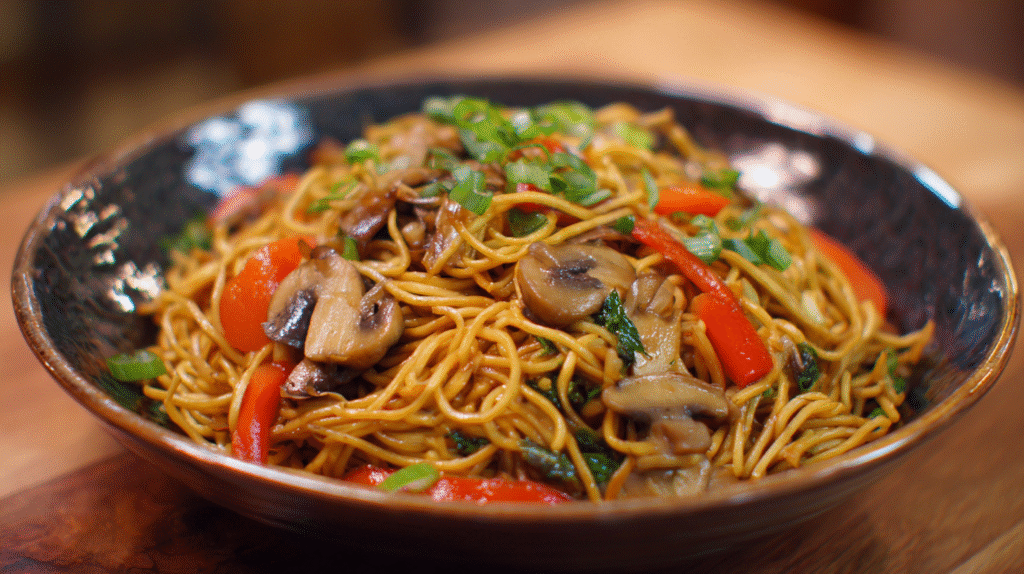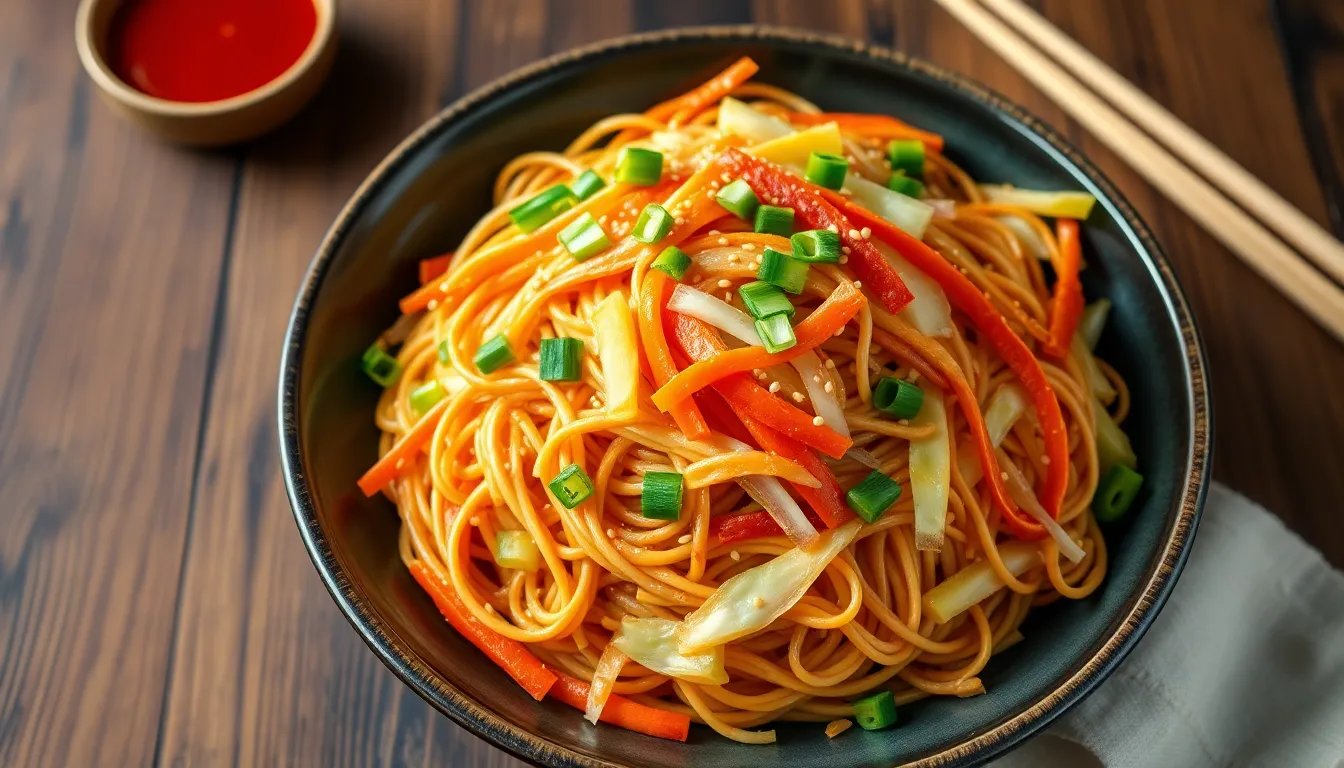Ingredients
This chow mein recipe requires simple ingredients that create complex flavors. You can find most items at your local grocery store with a few sauce essentials from the Asian aisle.
For the Noodles
- 8 oz fresh chow mein noodles or 6 oz dried lo mein noodles
- 2 tablespoons vegetable oil for cooking
- 1 tablespoon sesame oil
For the Sauce
- 3 tablespoons soy sauce (low sodium preferred)
- 1 tablespoon oyster sauce
- 1 teaspoon dark soy sauce (for color)
- 1 teaspoon cornstarch
- 1 teaspoon sugar
- 2 tablespoons chicken broth or water
- 1/2 teaspoon white pepper
For the Stir-Fry
- 8 oz boneless chicken thighs, sliced thin (or protein of choice)
- 2 cups napa cabbage, chopped
- 1 cup bean sprouts
- 1 medium carrot, julienned
- 2 green onions, cut into 2-inch pieces
- 3 cloves garlic, minced
- 1 tablespoon fresh ginger, minced
- 2 tablespoons vegetable oil for stir-frying
Equipment Needed

You need a large wok or heavy-bottomed skillet to achieve the signature smoky flavor and proper heat distribution that makes restaurant-style chow mein possible. A 14-inch carbon steel wok works best for tossing noodles without overflow, but a large cast iron or stainless steel skillet serves as an excellent alternative.
A large pot for boiling noodles is essential to cook your chow mein noodles properly without overcrowding. Choose a pot that holds at least 6 quarts of water to give the noodles plenty of room to move freely during cooking.
Sharp chef’s knife and cutting board allow you to prep vegetables quickly and uniformly. Consistent vegetable cuts ensure even cooking when you stir-fry everything together at high heat.
Two medium mixing bowls help you organize ingredients efficiently. Use one bowl for marinating your protein and another for combining the sauce ingredients before cooking begins.
Wooden spoon or wok spatula prevents scratching your cookware while providing the leverage needed to toss noodles and vegetables effectively. Bamboo or wooden tools work best since they won’t conduct heat and become too hot to handle.
Colander drains your cooked noodles quickly and thoroughly. Proper drainage prevents excess water from diluting your sauce and creating soggy chow mein.
Small whisk combines your sauce ingredients smoothly and eliminates any lumps from cornstarch. Whisking ensures your sauce has the proper consistency for coating noodles evenly.
| Equipment | Purpose | Alternative Option |
|---|---|---|
| 14-inch wok | High heat stir-frying | Large cast iron skillet |
| 6-quart pot | Boiling noodles | Any large stockpot |
| Chef’s knife | Vegetable prep | Sharp santoku knife |
| Medium bowls (2) | Ingredient organization | Any mixing bowls |
| Wooden spatula | Stir-frying | Heat-resistant silicone spatula |
| Colander | Draining noodles | Fine mesh strainer |
| Small whisk | Sauce mixing | Fork for whisking |
Gas burner provides the most authentic cooking experience since it delivers instant heat control that mimics professional wok cooking. Electric stoves work adequately but require preheating your wok or skillet thoroughly before adding ingredients.
Instructions

Master this authentic chow mein recipe by following these step-by-step instructions. Each stage builds upon the previous to create restaurant-quality results in your own kitchen.
Prep the Ingredients
Start by slicing your boneless chicken thighs into thin strips against the grain. Cut each piece approximately 1/4 inch thick for even cooking. Julienne your carrots into matchstick pieces about 2 inches long. Slice the napa cabbage into 1-inch wide strips and separate the white stems from the green leaves. Chop your green onions diagonally into 1-inch pieces. Mince 3 cloves of garlic and grate 1 tablespoon of fresh ginger. Rinse your bean sprouts under cold water and drain thoroughly. Set all ingredients in separate bowls near your cooking station for easy access during stir-frying.
Prepare the Sauce
Whisk together soy sauce and oyster sauce in a medium bowl until combined. Add dark soy sauce for color depth and cornstarch to create the perfect glossy finish. Incorporate sugar to balance the saltiness and pour in chicken broth gradually while whisking. Season with white pepper and whisk until the cornstarch dissolves completely. The sauce should appear smooth without any lumps. Set this mixture aside where you can easily reach it during cooking.
Cook the Noodles
Bring a large pot of water to a rolling boil over high heat. Add fresh chow mein noodles and cook for 2-3 minutes until just tender but still firm to the bite. For dried lo mein noodles, follow package directions but reduce cooking time by 1 minute. Drain noodles immediately in a colander and rinse with cold water to stop the cooking process. Toss the drained noodles with 1 tablespoon of vegetable oil to prevent sticking. Spread them on a large plate to cool completely before stir-frying.
Stir-Fry the Vegetables and Protein

Heat your wok or large skillet over high heat until it begins to smoke lightly. Add 2 tablespoons of vegetable oil and swirl to coat the bottom. Immediately add chicken strips in a single layer and let them sear for 1-2 minutes without stirring. Stir-fry the chicken for another 2-3 minutes until golden brown and cooked through. Push chicken to one side of the wok and add minced garlic and ginger to the empty space. Stir-fry aromatics for 30 seconds until fragrant. Add carrot matchsticks and white cabbage stems first since they need more cooking time. Stir-fry vegetables for 2 minutes until they begin to soften but remain crisp.
Combine and Finish
Push all ingredients to one side of the wok and add the cooled noodles to the empty space. Pour half of the prepared sauce over the noodles and toss using your wooden spatula or tongs. Combine noodles with the chicken and vegetables, adding more sauce as needed to coat everything evenly. Add bean sprouts and green cabbage leaves during the last minute of cooking. Stir-fry everything together for 2-3 minutes until the noodles are heated through and slightly crispy on the bottom. Drizzle sesame oil around the edges of the wok and toss once more. Garnish with sliced green onions and serve immediately while hot.
Cooking Tips for Perfect Chow Mein

Master the art of high-heat cooking by preheating your wok or skillet until it begins to smoke lightly. This smoking point indicates the optimal temperature for achieving that coveted wok hei flavor that separates homemade chow mein from soggy takeout attempts. Your noodles will develop those signature crispy edges when the cooking surface reaches this crucial temperature.
Organize all your ingredients before you start cooking since chow mein demands quick execution. Cut your vegetables uniformly to ensure even cooking throughout the stir-fry process. Place each component in separate bowls within arm’s reach of your cooking station to prevent overcooking while you search for ingredients.
Cook your noodles one minute less than the package instructions suggest to achieve the perfect texture. Slightly undercooked noodles will finish cooking in the wok without becoming mushy. Drain them immediately and toss with a small amount of oil to prevent sticking while you prepare the other components.
Work in batches when stir-frying to avoid overcrowding your cooking surface. Overcrowded ingredients steam rather than sear which results in soggy vegetables and tough protein. Start with your protein first since it requires the longest cooking time then remove it temporarily while you cook the vegetables.
Add vegetables to your hot wok in order of cooking time required. Dense vegetables like carrots need more time than delicate bean sprouts or leafy greens. This sequential approach ensures every component reaches its ideal texture without overcooking the quicker-cooking ingredients.
Pour your sauce mixture around the edges of the wok rather than directly onto the ingredients. This technique allows the sauce to heat and concentrate before coating the noodles and vegetables. The hot wok surface will caramelize the sauce slightly which adds depth to the overall flavor profile.
Toss everything together using a lifting and folding motion rather than stirring in circles. This technique prevents the noodles from breaking while ensuring even sauce distribution. Keep the ingredients moving constantly to prevent sticking and promote even heating throughout the mixture.
Taste and adjust seasoning during the final moments of cooking when all ingredients are combined. Add a splash of soy sauce for saltiness or a pinch of sugar to balance any excessive saltiness. Your palate is the best guide for achieving the perfect flavor balance in your finished dish.
Serve your chow mein immediately while the noodles retain their optimal texture contrast. The dish continues cooking from residual heat even after removing it from the stove. Transfer it to warmed serving plates to maintain the ideal temperature for the best dining experience.
Variations and Substitutions
You can easily customize this chow mein recipe to match your preferences and dietary needs. These versatile swaps allow you to create countless delicious variations using ingredients you already have on hand.
Protein Options
Beef: Slice flank steak or sirloin against the grain into thin strips. Marinate the beef in soy sauce and cornstarch for 15 minutes before cooking.
Pork: Cut pork tenderloin or shoulder into bite-sized pieces. Cook pork thoroughly until it reaches an internal temperature of 145°F.
Shrimp: Use large shrimp peeled and deveined. Add shrimp during the last 2-3 minutes of cooking to prevent overcooking.
Tofu: Press extra-firm tofu to remove moisture then cube into 1-inch pieces. Pan-fry tofu until golden before adding to the stir-fry.
Egg: Scramble 3-4 eggs separately then fold into the finished noodles for classic egg chow mein.
Mixed proteins: Combine chicken and shrimp or beef and pork for restaurant-style combination chow mein.
Vegetable Alternatives
Bok choy: Replace napa cabbage with baby bok choy cut into 2-inch pieces. Add stems first then leaves after 1 minute.
Snow peas: Substitute bean sprouts with fresh snow peas trimmed and cut diagonally.
Bell peppers: Add red or yellow bell peppers cut into thin strips for extra color and crunch.
Mushrooms: Include sliced shiitake or button mushrooms cooked until they release their moisture.
Broccoli: Use small broccoli florets blanched for 2 minutes before stir-frying.
Celery: Add thinly sliced celery for additional texture and traditional flavor.
Water chestnuts: Include sliced water chestnuts for authentic crunch and mild flavor.
Noodle Substitutes
Ramen noodles: Use fresh ramen noodles without the seasoning packet. Cook according to package directions then drain thoroughly.
Rice noodles: Substitute with wide rice noodles soaked in warm water until pliable. Drain well before stir-frying.
Udon noodles: Fresh or frozen udon noodles work well. Rinse frozen udon under warm water to separate.
Spaghetti: Regular spaghetti makes an acceptable substitute when Asian noodles are unavailable. Cook al dente for best results.
Lo mein noodles: Use fresh lo mein noodles interchangeably with chow mein noodles. Both work equally well in this recipe.
Egg noodles: Wide egg noodles provide similar texture and flavor to traditional chow mein noodles.
Make-Ahead Instructions
Your chow mein preparation becomes incredibly efficient when you plan components in advance. Start by washing and cutting all vegetables up to 24 hours before cooking. Store the prepped napa cabbage, carrots, and green onions in separate airtight containers in your refrigerator to maintain optimal freshness.
You can prepare the signature sauce mixture up to three days ahead of time. Whisk together the soy sauce, oyster sauce, dark soy sauce, cornstarch, sugar, chicken broth, and white pepper in a sealed container. Refrigerate this mixture and give it a quick stir before using since the cornstarch may settle.
Your protein requires different advance preparation depending on your choice. Slice chicken thighs into thin strips and marinate them in a tablespoon of soy sauce and sesame oil for enhanced flavor development. This marinated chicken stays fresh in the refrigerator for up to two days when properly covered.
Fresh chow mein noodles benefit from advance preparation as well. You can blanch them according to package directions and drain thoroughly. Toss the cooled noodles with a light coating of vegetable oil to prevent sticking. Store these prepared noodles in your refrigerator for up to two days in an airtight container.
Organizing your mise en place saves valuable time during the actual cooking process. Arrange all prepped ingredients in small bowls near your cooking station. Place proteins, vegetables, sauce, and noodles within easy reach of your wok or skillet for seamless execution.
Freezing components extends your make ahead options significantly. Your prepared sauce mixture freezes well for up to one month in ice cube trays for perfect portion control. Blanched noodles also freeze successfully when stored in freezer bags with excess air removed. Thaw frozen components overnight in your refrigerator before cooking.
Your final assembly requires only fresh cooking when ingredients are prepped in advance. Heat your wok while organizing the prepared components. This streamlined approach reduces your active cooking time to just 10 minutes while maintaining the authentic wok hei flavor that makes restaurant quality chow mein at home.
Storage and Reheating
Your homemade chow mein stays fresh for up to 3 days when stored properly in the refrigerator. Allow the noodles to cool completely before transferring them to airtight containers to prevent condensation buildup. Store the chow mein in shallow containers rather than deep ones for even cooling and easier reheating access.
Refrigerator Storage
Divide leftover chow mein into individual serving portions using glass containers with tight-fitting lids. This method makes reheating more convenient and helps maintain the dish’s texture quality. Place the containers in the main refrigerator compartment rather than the door to ensure consistent temperature control.
Keep the storage temperature at 40°F or below to maintain food safety standards. Label containers with the preparation date to track freshness accurately. Consume refrigerated chow mein within 72 hours for optimal flavor and texture retention.
Freezer Storage
Freeze chow mein for up to 2 months in freezer-safe containers or heavy-duty freezer bags. Remove excess air from bags before sealing to prevent freezer burn and texture degradation. Portion the noodles into meal-sized servings before freezing for convenient defrosting.
Wrap containers with aluminum foil for additional protection against temperature fluctuations. Store frozen chow mein at 0°F or below for maximum quality preservation. Thaw frozen portions overnight in the refrigerator before reheating.
Reheating Methods
Stovetop Method: Heat 1 tablespoon of oil in your wok or large skillet over medium-high heat. Add the chilled chow mein and stir-fry for 3-4 minutes until heated through. Sprinkle 2 tablespoons of water or chicken broth to restore moisture during reheating.
Microwave Method: Place chow mein in a microwave-safe dish and cover with a damp paper towel. Heat in 30-second intervals at 70% power until warmed throughout. Stir between intervals to ensure even heating distribution.
Oven Method: Preheat your oven to 350°F and transfer chow mein to an oven-safe dish. Cover tightly with foil and heat for 10-15 minutes until thoroughly warmed. Add a splash of broth before covering to prevent drying.
| Reheating Method | Temperature | Time | Best For |
|---|---|---|---|
| Stovetop | Medium-high | 3-4 minutes | Best texture retention |
| Microwave | 70% power | 1-2 minutes | Quick individual portions |
| Oven | 350°F | 10-15 minutes | Large batches |
Quality Maintenance Tips
Add fresh bean sprouts or green onions during reheating to restore crunchiness and vibrant flavor. Avoid reheating the same portion multiple times as this breaks down the noodle texture significantly. Test the internal temperature reaches 165°F before serving reheated chow mein for food safety compliance.
Refresh the dish with a small amount of fresh sauce mixture if the noodles appear dry after storage. The original wok hei flavor diminishes during storage but proper reheating techniques help maintain the dish’s authentic taste profile.
Serving Suggestions
Your freshly made chow mein pairs beautifully with classic Chinese side dishes that complement its savory flavors. Serve alongside crispy spring rolls or pot stickers for a complete takeout-style meal at home. Steamed dumplings make an excellent appetizer that won’t compete with the bold flavors of your main dish.
Transform your chow mein into a restaurant-quality presentation by garnishing with freshly sliced green onions and toasted sesame seeds. A sprinkle of crushed red pepper flakes adds visual appeal and extra heat for those who enjoy spicy dishes. Fresh cilantro leaves provide a bright herbal note that balances the rich sauce.
Consider serving your chow mein family-style in a large serving bowl or platter to encourage sharing. Individual portions work well when plated in shallow bowls that showcase the colorful vegetables and golden noodles. Chopsticks are traditional but providing both chopsticks and forks ensures all your guests can enjoy the meal comfortably.
Hot tea makes the perfect beverage pairing with chow mein’s rich flavors. Green tea or oolong tea cuts through the dish’s savory elements while jasmine tea adds a fragrant floral note. For non-tea drinkers, sparkling water with lime provides a refreshing contrast to the warm noodles.
Add variety to your meal by serving different protein versions of chow mein simultaneously. Create a chicken chow mein alongside a vegetarian version to accommodate different dietary preferences. This approach allows everyone to customize their plate while sharing the same delicious base recipe.
Your chow mein also works wonderfully as part of a larger Chinese feast. Pair it with sweet and sour dishes like orange chicken or Beijing beef for contrasting flavors. Steamed rice provides a neutral base that soaks up any extra sauce from your perfectly seasoned noodles.
Conclusion
You now have everything you need to create authentic restaurant-quality chow mein in your own kitchen. This versatile dish adapts perfectly to your preferences and whatever ingredients you have on hand.
The key to success lies in proper preparation and high heat cooking. Remember to have all your ingredients ready before you start and don’t be afraid to experiment with different proteins and vegetables.
With practice you’ll develop the technique to achieve that coveted wok hei flavor that makes homemade chow mein truly special. Your family and friends will be amazed at how closely your creation rivals their favorite takeout spot.
Start cooking tonight and discover just how satisfying it is to master this beloved Chinese-American classic. Your taste buds will thank you for the authentic flavors and fresh ingredients.

